Regional Spatiotemporal Patterns of Fire in the Eurasian Subarctic Based on Satellite Imagery
Abstract
:1. Introduction
- The different patterns of fires in sub-regions of Eurasian Subarctic and the associated driving factors.
- Trends in the start-dates, duration of fire season, and the northern limit of fires.
- The association of fire behavior, including the speed of the propagation of fire fronts, with land-cover type.
- A comparison of fire behavior in the Eurasian Subarctic with the adjacent region to the south.
2. Materials and Methods
2.1. Processing of Coarse Resolution Data
2.2. Processing of Medium Resolution Data
2.3. Definition of High Fire Incidence Year and Peak Fire Season
2.4. Generation of Fine Resolution Data
2.4.1. Fire Perimeter Dataset
2.4.2. Fire Front Dataset
3. Results
3.1. Temporal Trends in Fires
- In region A, which covers the East European and West Siberian Plain, the fire frequency, burnt area, and carbon emissions from biomass burning show perennial low fire occurrence, with the largest peak in 2012. Region A comprises 40% of the Eurasian Subarctic land area and is larger than regions B and C but, nevertheless, only ac-counts for a minority of the fires: 10% of the total number of fire pixels, 9% of the burnt area, and 8% of carbon emissions from biomass burning.
- In region B, which covers the Central Siberian Plateau, the patterns of fire frequency, burnt area, and carbon emissions from biomass burning appear to have changed from 2012 onwards. With the exception of 2001 and 2002, fire frequency, burnt area, and carbon emissions from biomass burning were low prior to 2012. From 2012 onward, fire metrics were consistently high each year, with the only exception being 2015. Fire frequency and carbon emissions both suggest rising fire occurrence in recent years with unusually high peaks in 2021. The 2021 peak in carbon emissions from biomass burning is particularly large, increasing by 3.6 times compared to that of 2020, when the fire frequency increased by only 1.9 times. This increase could be caused by fires that were more intense (i.e., burnt more of the available fuels), or burnt land with larger carbon reservoirs [26]. The median values of fire frequency, burnt area, and carbon emissions from biomass burning between 2012 and 2021 are 5.7 times, 4.6 times, and 5.3 times the equivalent values for the period between 2001 and 2011. Overall, these statistics suggest a switch to higher fire occurrence, with more frequent fires, larger burnt area, and increased carbon emissions from 2012 onwards for this region.
- For region C, which covers the East Siberian Highlands, the fire frequency, burnt area, and biomass burning carbon emissions show a marked periodicity. The time series is characterized by a majority of years with relatively low fire frequency, burnt area, and carbon emissions, punctuated by intermittent years with unusually high values in 2003, 2010, and 2020. The preceding 1–2 years before each peak in the active fire numbers are also typically elevated, though substantially lower than the peak.
3.2. Latitudinal and Longitudinal Trends in Fire Incidence
3.3. Fire Season Trends
3.4. Fires on Different Land-Cover Types
3.5. Propagation Characteristics of Individual Fires
4. Discussion
4.1. Factors Affecting Fire Patterns
4.1.1. Weather
4.1.2. Land Cover
4.1.3. Landscape Structure
4.2. Future Fire Risks in the Eurasian Subarctic
5. Conclusions
Author Contributions
Funding
Data Availability Statement
Acknowledgments
Conflicts of Interest
References
- McCarty, J.L.; Aalto, J.; Paunu, V.V.; Arnold, S.R.; Eckhardt, S.; Klimont, Z.; Fain, J.J.; Evangeliou, N.; Venäläinen, A.; Tchebakova, N.M.; et al. Reviews and syntheses: Arctic fire regimes and emissions in the 21st century. Biogeosciences 2021, 18, 5053–5083. [Google Scholar] [CrossRef]
- Mishra, U.; Jastrow, J.D.; Matamala, R.; Hugelius, G.; Koven, C.D.; Harden, J.W.; Ping, C.L.; Michaelson, G.J.; Fan, Z.; Miller, R.M.; et al. Empirical estimates to reduce modeling uncertainties of soil organic carbon in permafrost regions: A review of recent progress and remaining challenges. Environ. Res. Lett. 2013, 8, 9. [Google Scholar] [CrossRef]
- Hugelius, G.; Strauss, J.; Zubrzycki, S.; Harden, J.W.; Schuur, E.A.G.; Ping, C.L.; Schirrmeister, L.; Grosse, G.; Michaelson, G.J.; Koven, C.D.; et al. Estimated stocks of circumpolar permafrost carbon with quantified uncertainty ranges and identified data gaps. Biogeosciences 2014, 11, 6573–6593. [Google Scholar] [CrossRef] [Green Version]
- Scharlemann, J.P.W.; Tanner, E.V.J.; Hiederer, R.; Kapos, V. Global soil carbon: Understanding and managing the largest terrestrial carbon pool. Carbon Manag. 2014, 5, 81–91. [Google Scholar] [CrossRef]
- White, D.M.; Garland, D.S.; Ping, C.L.; Michaelson, G. Characterizing soil organic matter quality in arctic soil by cover type and depth. Cold Reg. Sci. Technol. 2004, 38, 63–73. [Google Scholar] [CrossRef]
- Hugelius, G.; Tarnocai, C.; Broll, G.; Canadell, J.G.; Kuhry, P.; Swanson, D.K. The Northern Circumpolar Soil Carbon Database: Spatially distributed datasets of soil coverage and soil carbon storage in the northern permafrost regions. Earth Syst. Sci. Data 2013, 5, 3–13. [Google Scholar] [CrossRef] [Green Version]
- Hu, Y.; Fernandez-Anez, N.; Smith, T.E.L.; Rein, G. Review of emissions from smouldering peat fires and their contribution to regional haze episodes. Int. J. Wildland Fire 2018, 27, 293–312. [Google Scholar] [CrossRef]
- McCarty, J.L.; Smith, T.E.L.; Turetsky, M.R. Arctic fires re-emerging. Nat. Geosci. 2020, 13, 658–660. [Google Scholar] [CrossRef]
- Jones, B.M.; Grosse, G.; Arp, C.D.; Miller, E.; Liu, L.; Hayes, D.J.; Larsen, C.F. Recent Arctic tundra fire initiates widespread thermokarst development. Sci. Rep. 2015, 5, 15865. [Google Scholar] [CrossRef] [Green Version]
- Kharuk, V.I.; Ponomarev, E.I.; Ivanova, G.A.; Dvinskaya, M.L.; Coogan, S.C.; Flannigan, M.D. Wildfires in the Siberian taiga. Ambio 2021, 50, 1953–1974. [Google Scholar] [CrossRef]
- Feurdean, A.; Florescu, G.; Tanţău, I.; Vannière, B.; Diaconu, A.C.; Pfeiffer, M.; Warren, D.; Hutchinson, S.M.; Gorina, N.; Gałka, M.; et al. Recent fire regime in the southern boreal forests of western Siberia is unprecedented in the last five millennia. Quat. Sci. Rev. 2020, 244, 106495. [Google Scholar] [CrossRef]
- Smirnov, N.S.; Korotkov, V.N.; Romanovskaya, A.A. Black carbon emissions from wildfires on forest lands of the Russian Federation in 2007–2012. Russ. Meteorol. Hydrol. 2015, 40, 435–442. [Google Scholar] [CrossRef]
- York, A.; Bhatt, U.S.; Gargulinski, E.; Grabinski, Z.; Jain, P.; Soja, A.; Thoman, R.L.; Ziel, R. Wildland Fire in High Northern Latitudes. In Arctic Report Card 2020; Thoman, R.L., Richter-Menge, J., Druckenmiller, M.L., Eds.; NOAA Institutional Repository, 2020. [Google Scholar] [CrossRef]
- Talucci, A.C.; Loranty, M.M.; Alexander, H.D. Siberian taiga and tundra fire regimes from 2001–2020. Environ. Res. Lett. 2022, 17, 025001. [Google Scholar] [CrossRef]
- Kirillina, K.; Shvetsov, E.G.; Protopopova, V.V.; Thiesmeyer, L.; Yan, W. Consideration of anthropogenic factors in boreal forest fire regime changes during rapid socio-economic development: Case study of forestry districts with increasing burnt area in the Sakha Republic, Russia. Environ. Res. Lett. 2020, 15, 035009. [Google Scholar] [CrossRef]
- Giglio, L.; Schroeder, W.; Justice, C.O. The collection 6 MODIS active fire detection algorithm and fire products. Remote Sens. Environ. 2016, 178, 31–41. [Google Scholar] [CrossRef] [PubMed] [Green Version]
- Randerson, J.T.; Van Der Werf, G.R.; Giglio, L.; Collatz, G.J.; Kasibhatla, P.S. Global Fire Emissions Database, Version 4.1 (GFEDv4); ORNL DAAC: Oak Ridge, TN, USA, 2018. [CrossRef]
- Giglio, L.; Boschetti, L.; Roy, D.; Hoffmann, A.A.; Humber, M.; Hall, J.V. Collection 6 Modis Burned Area Product User’s Guide Version 1.0; NASA EOSDIS Land Processes DAAC: Sioux Falls, SD, USA, 2016. Available online: https://lpdaac.usgs.gov/documents/875/MCD64_User_Guide_V6.pdf (accessed on 19 October 2021).
- Artés, T.; Oom, D.; De Rigo, D.; Durrant, T.H.; Maianti, P.; Libertà, G.; San-Miguel-Ayanz, J. A global wildfire dataset for the analysis of fire regimes and fire behaviour. Sci. Data 2019, 6, 296. [Google Scholar] [CrossRef] [PubMed] [Green Version]
- ESA. Land Cover CCI Product User Guide Version 2. Technical Report. 2017. Available online: maps.elie.ucl.ac.be/CCI/viewer/download/ESACCI-LC-Ph2-PUGv2_2.0.pdf (accessed on 27 October 2021).
- Hayasaka, H. Rare and extreme wildland fire in Sakha in 2021. Atmosphere 2021, 12, 1572. [Google Scholar] [CrossRef]
- Lutes, D.C.; Keane, R.E.; Caratti, J.F.; Key, C.H.; Benson, N.C.; Sutherland, S.; Gangi, L.J. Firemon: Fire Effects Monitoring and Inventory System; General Technical Report RMRS-GTR-164-CD; US Department of Agriculture, Forest Service, Rocky Mountain Research Station: Fort Collins, CO, USA, 2006; Volume 1. [CrossRef]
- Cicala, L.; Angelino, C.V.; Fiscante, N.; Ullo, S.L. Landsat-8 and Sentinel-2 for fire monitoring at a local scale: A case study on Vesuvius. In Proceedings of the 2018 IEEE International Conference on Environmental Engineering (EE), Milan, Italy, 12–14 March 2018; pp. 1–6. [Google Scholar] [CrossRef]
- Virtanen, P.; Gommers, R.; Oliphant, T.E.; Haberland, M.; Reddy, T.; Cournapeau, D.; Burovski, E.; Peterson, P.; Weckesser, W.; Bright, J.; et al. SciPy 1.0: Fundamental algorithms for scientific computing in Python. Nat. Methods 2020, 17, 261–272. [Google Scholar] [CrossRef] [PubMed] [Green Version]
- Otón, G.; Lizundia-Loiola, J.; Pettinari, M.L.; Chuvieco, E. Development of a consistent global long-term burned area product (1982–2018) based on AVHRR-LTDR data. Int. J. Appl. Earth Obs. Geoinf. 2021, 103, 102473. [Google Scholar] [CrossRef]
- Van Der Werf, G.R.; Randerson, J.T.; Giglio, L.; Van Leeuwen, T.T.; Chen, Y.; Rogers, B.M.; Mu, M.; Van Marle, M.J.; Morton, D.C.; Collatz, G.J.; et al. Global fire emissions estimates during 1997–2016. Earth Syst. Sci. Data 2017, 9, 697–720. [Google Scholar] [CrossRef] [Green Version]
- Valendik, E.N. Basic principles of boreal forest fire protection in Eurasia. In Fire in ecosystem management: Shifting the paradigm from suppression to prescription. Proc. Tall Timbers Fire Ecol. Conf. 1998, 20, 398–402. [Google Scholar]
- Walker, X.J.; Rogers, B.M.; Veraverbeke, S.; Johnstone, J.F.; Baltzer, J.L.; Barrett, K.; Bourgeau-Chavez, L.; Day, N.J.; de Groot, W.J.; Dieleman, C.M.; et al. Fuel availability not fire weather controls boreal wildfire severity and carbon emissions. Nat. Clim. Chang. 2020, 10, 1130–1136. [Google Scholar] [CrossRef]
- Veraverbeke, S.; Delcourt, C.J.; Kukavskaya, E.; Mack, M.; Walker, X.; Hessilt, T.; Rogers, B.; Scholten, R.C. Direct and longer-term carbon emissions from arctic-boreal fires: A short review of recent advances. Curr. Opin. Environ. Sci. Health 2021, 23, 100277. [Google Scholar] [CrossRef]
- Krawchuk, M.A.; Moritz, M.A.; Parisien, M.A.; Van Dorn, J.; Hayhoe, K. Global pyrogeography: The current and future distribution of wildfire. PLoS ONE 2009, 4, e5102. [Google Scholar] [CrossRef] [PubMed]
- Jain, P.; Castellanos-Acuna, D.; Coogan, S.C.P.; Abatzoglou, J.T.; Flannigan, M.D. Observed increases in extreme fire weather driven by atmospheric humidity and temperature. Nat. Clim. Chang. 2022, 12, 63–70. [Google Scholar] [CrossRef]
- Hersbach, H.; Bell, B.; Berrisford, P.; Hirahara, S.; Horányi, A.; Muñoz-Sabater, J.; Nicolas, J.; Peubey, C.; Radu, R.; Schepers, D.; et al. The ERA5 global reanalysis. Q. J. R. Meteorol. Soc. 2020, 146, 1999–2049. [Google Scholar] [CrossRef]
- Adler, R. Global Precipitation Climatology Project (GPCP) Climate Data Record (CDR), Version 2.3 (Monthly). National Centers for Environmental Information. Available online: https://www.ncei.noaa.gov/access/metadata/landing-page/bin/iso?id=gov.noaa.ncdc:C00979 (accessed on 12 June 2022).
- Muñoz Sabater, J. ERA5-Land Hourly Data from 1981 to Present. Copernicus Climate Change Service (C3S) Climate Data Store (CDS). Available online: https://cds.climate.copernicus.eu/cdsapp#!/dataset/10.24381/cds.e2161bac (accessed on 1 July 2022).
- Nelson, R.M., Jr. An effective wind speed for models of fire spread. Int. J. Wildland Fire 2002, 11, 153–161. [Google Scholar] [CrossRef]
- Hersbach, H.; Bell, B.; Berrisford, P.; Biavati, G.; Horányi, A.; Muñoz Sabater, J.; Nicolas, J.; Peubey, C.; Radu, R.; Rozum, I.; et al. ERA5 Hourly Data on Pressure Levels from 1979 to Present. Copernicus Climate Change Service (c3s) Climate Data Store (cds). 2018. Available online: https://cds.climate.copernicus.eu/cdsapp#!/dataset/10.24381/cds.bd0915c6?tab=overview (accessed on 28 June 2022).
- Abatzoglou, J.T.; Kolden, C.A. Relative importance of weather & climate on wildfire growth in interior Alaska. Int. J. Wildland Fire 2011, 20, 479–486. [Google Scholar] [CrossRef]
- Hayasaka, H.; Yamazaki, K.; Naito, D. Weather conditions and warm air masses during active fire-periods in boreal forests. Polar Sci. 2019, 22, 100472. [Google Scholar] [CrossRef]
- Holzworth, R.H.; Brundell, J.B.; McCarthy, M.P.; Jacobson, A.R.; Rodger, C.J.; Anderson, T.S. Lightning in the Arctic. Geophys. Res. Lett. 2021, 48, e2020GL091366. [Google Scholar] [CrossRef]
- Kaplan, J.O.; Lau, K.H.K. The WGLC global gridded lightning climatology and time series. Earth Sys. Sci. Data 2021, 13, 3219–3237. [Google Scholar] [CrossRef]
- Barros, A.M.; Pereira, J.M. Wildfire selectivity for land cover type: Does size matter? PLoS ONE 2014, 9, e84760. [Google Scholar] [CrossRef] [PubMed]
- Calviño-Cancela, M.; Chas-Amil, M.L.; García-Martínez, E.D.; Touza, J. Wildfire risk associated with different vegetation types within and outside wildland-urban interfaces. For. Ecol. Manag. 2016, 372, 1–9. [Google Scholar] [CrossRef] [Green Version]
- Nunes, M.; Vasconcelos, M.J.; Pereira, J.; Dasgupta, N.; Alldredge, R.J.; Rego, F.C. Land cover type and fire in Portugal: Do fires burn land cover selectively? Landsc. Ecol. 2005, 20, 661–673. [Google Scholar] [CrossRef]
- Moreira, F.; Vaz, P.; Catry, F.; Silva, J.S. Regional variations in wildfire susceptibility of land-cover types in Portugal: Implications for landscape management to minimize fire hazard. Int. J. Wildland Fire 2009, 18, 563–574. [Google Scholar] [CrossRef]
- Povak, N.A.; Hessburg, P.F.; Salter, R.B. Evidence for scale-dependent topographic controls on wildfire spread. Ecosphere 2018, 9, e02443. [Google Scholar] [CrossRef] [Green Version]
- Vinas, M.J. NASA’s Earth Science News Team. 2019. Available online: https://www.nasa.gov/feature/goddard/2019/nasa-studies-how-arctic-wildfires-change-the-world (accessed on 13 July 2022).
- Soja, A.J.; Cofer, W.R.; Shugart, H.H.; Sukhinin, A.I.; Stackhouse, P.W., Jr.; McRae, D.J.; Conard, S.G. Estimating fire emissions and disparities in boreal Siberia (1998–2002). J. Geophys. Res. Atmos. 2004, 109, D14. [Google Scholar] [CrossRef]
- Overland, J.E.; Hanna, E.; Hanssen-Bauer, I.; Kim, S.J.; Walsh, J.E.; Wang, M.; Bhatt, U.S.; Thoman, R.L.; Ballinger, T.J. Surface air Temperature. Arct. Rep. Card 2015, 2015, 10–16. [Google Scholar] [CrossRef]
- De Groot, W.J.; Flannigan, M.D.; Cantin, A.S. Climate change impacts on future boreal fire regimes. For. Ecol. Manag. 2013, 294, 35–44. [Google Scholar] [CrossRef]
- Overland, J.E.; Wang, M.; Walsh, J.E.; Stroeve, J.C. Future Arctic climate changes: Adaptation and mitigation time scales. Earth’s Future 2014, 2, 68–74. [Google Scholar] [CrossRef]
- Flannigan, M.D.; Amiro, B.D.; Logan, K.A.; Stocks, B.J.; Wotton, B.M. Forest fires and climate change in the 21st century. Mitig. Adapt. Strateg. Glob. Chang. 2006, 11, 847–859. [Google Scholar] [CrossRef]
- Jolly, W.M.; Cochrane, M.A.; Freeborn, P.H.; Holden, Z.A.; Brown, T.J.; Williamson, G.J.; Bowman, D.M. Climate-induced variations in global wildfire danger from 1979 to 2013. Nat. Commun. 2015, 6, 7537. [Google Scholar] [CrossRef] [PubMed] [Green Version]
- Sun, Y.; Chen, H.; Zhu, S.; Zhang, J.; Wei, J. Influence of the Eurasian spring snowmelt on summer land surface warming over Northeast Asia and its associated mechanism. J. Clim. 2021, 34, 4851–4869. [Google Scholar] [CrossRef]
- Westerling, A.L.; Hidalgo, H.G.; Cayan, D.R.; Swetnam, T.W. Warming and earlier spring increase western US forest wildfire activity. Science 2006, 313, 940–943. [Google Scholar] [CrossRef] [Green Version]
- Sizov, O.; Ezhova, E.; Tsymbarovich, P.; Soromotin, A.; Prihod’ko, N.; Petäjä, T.; Zilitinkevich, S.; Kulmala, M.; Bäck, J.; Köster, K. Fire and vegetation dynamics in northwest Siberia during the last 60 years based on high-resolution remote sensing. Biogeosciences 2021, 18, 207–228. [Google Scholar] [CrossRef]
- Fischer, E.M.; Knutti, R. Robust projections of combined humidity and temperature extremes. Nat. Clim. Chang. 2013, 3, 126–130. [Google Scholar] [CrossRef]
- Chen, Y.; Romps, D.M.; Seeley, J.T.; Veraverbeke, S.; Riley, W.J.; Mekonnen, Z.A.; Randerson, J.T. Future increases in Arctic lightning and fire risk for permafrost carbon. Nat. Clim. Chang. 2021, 11, 404–410. [Google Scholar] [CrossRef]
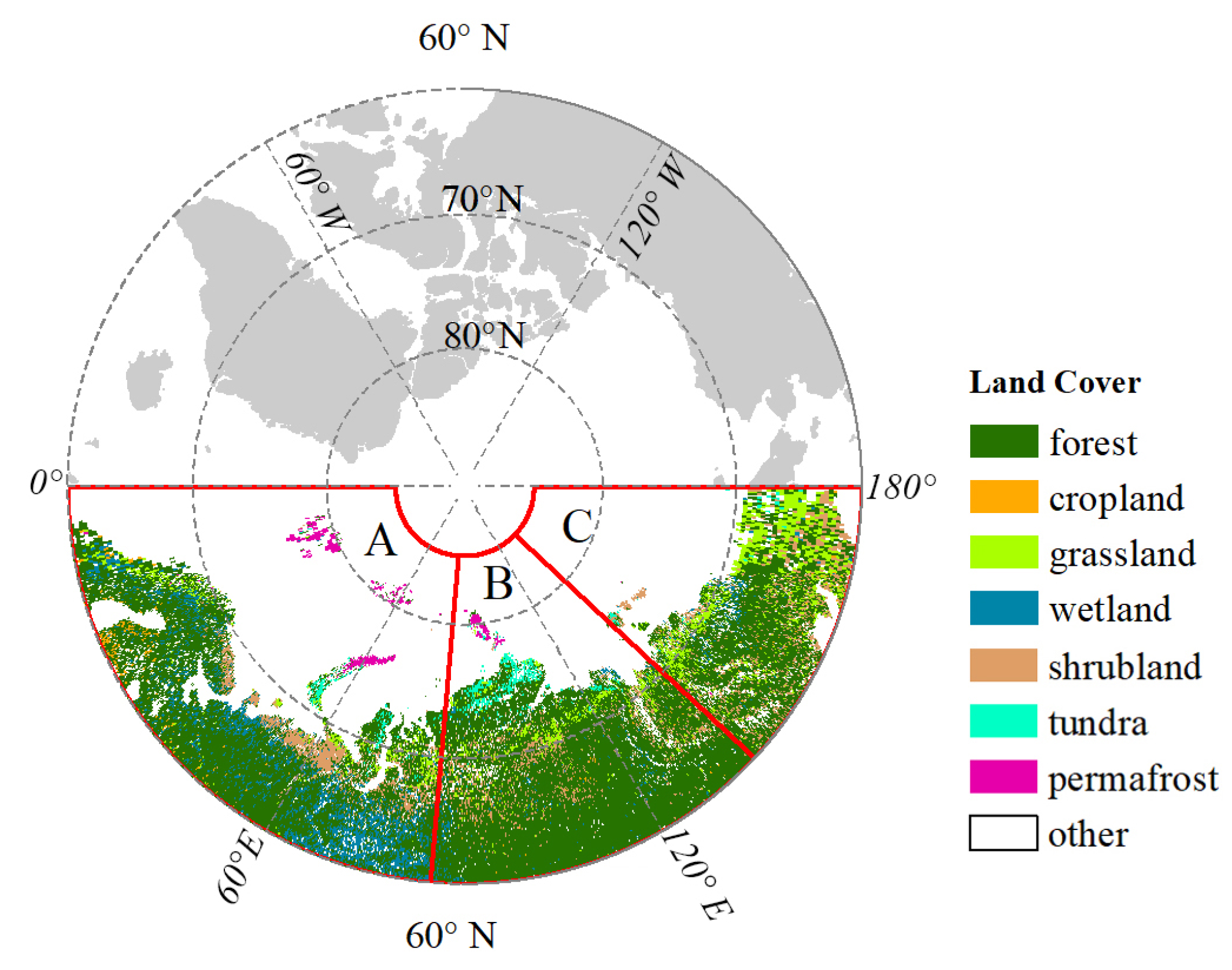


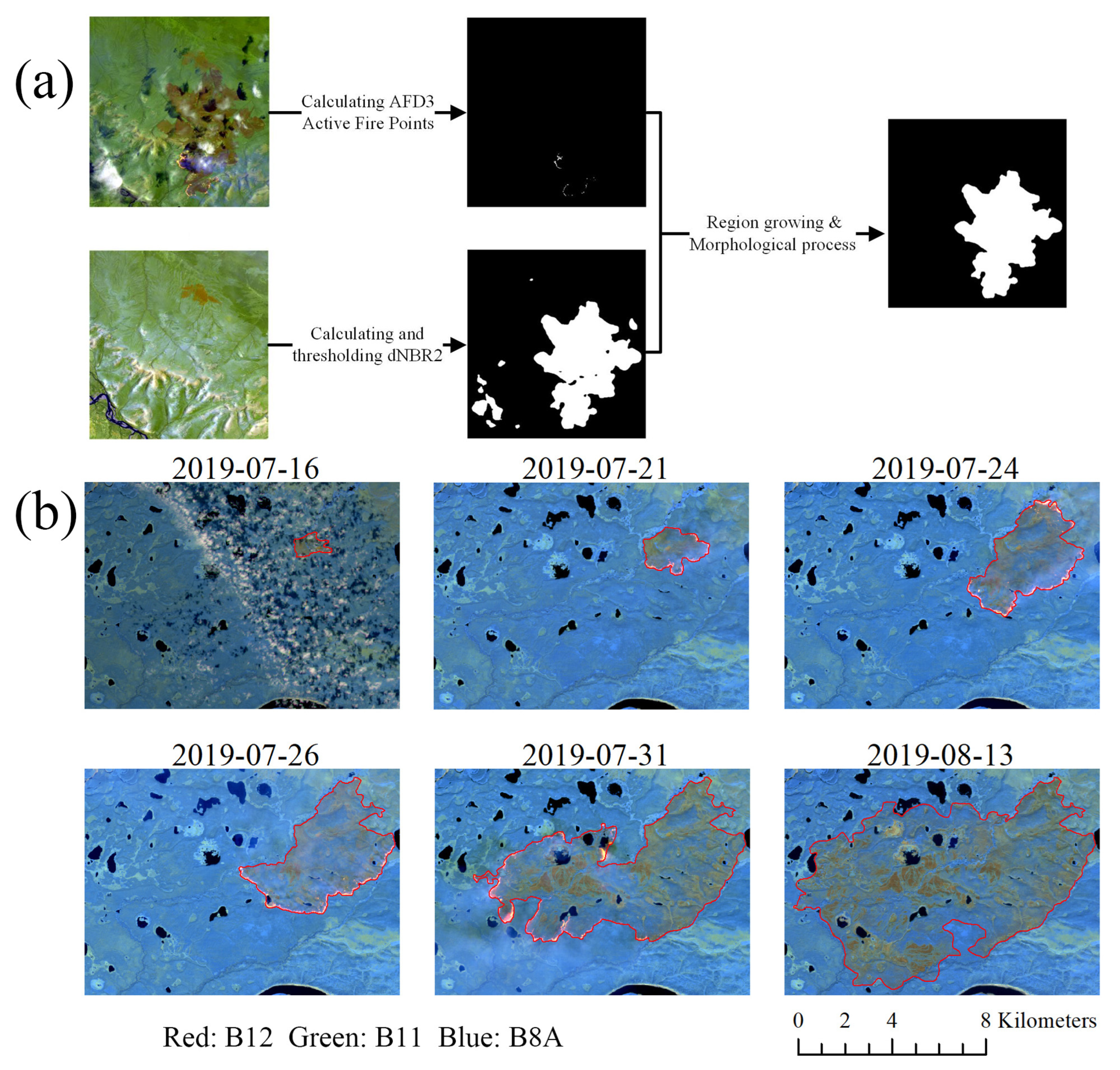
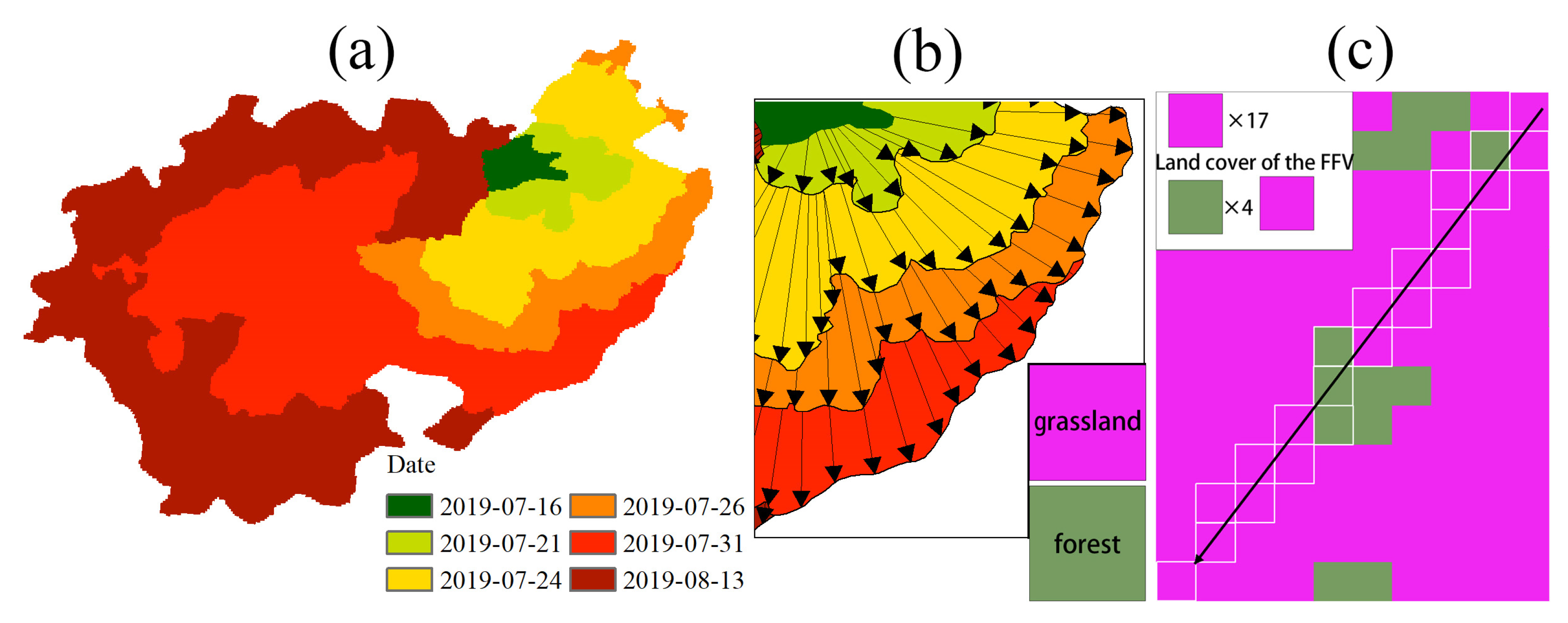

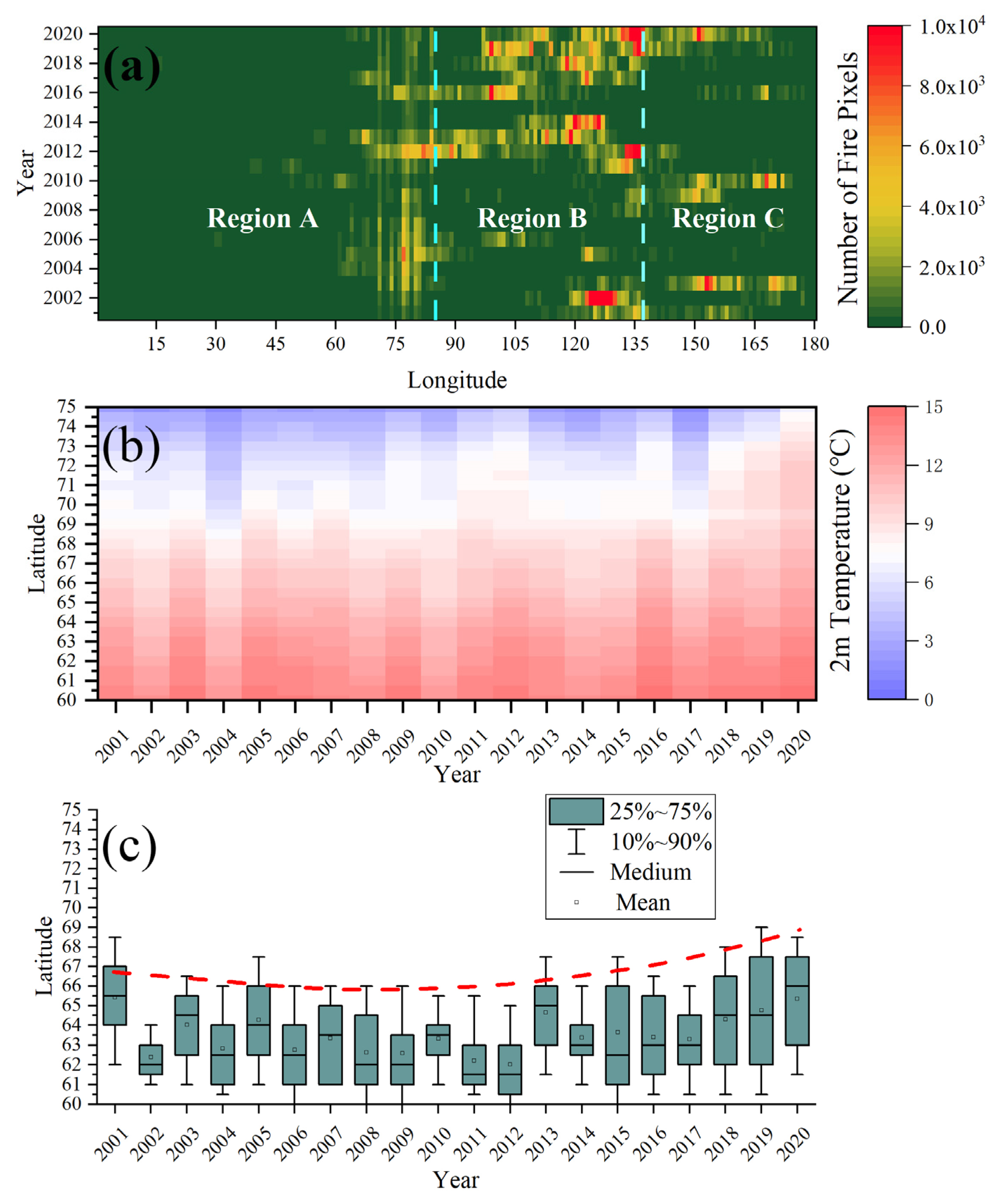


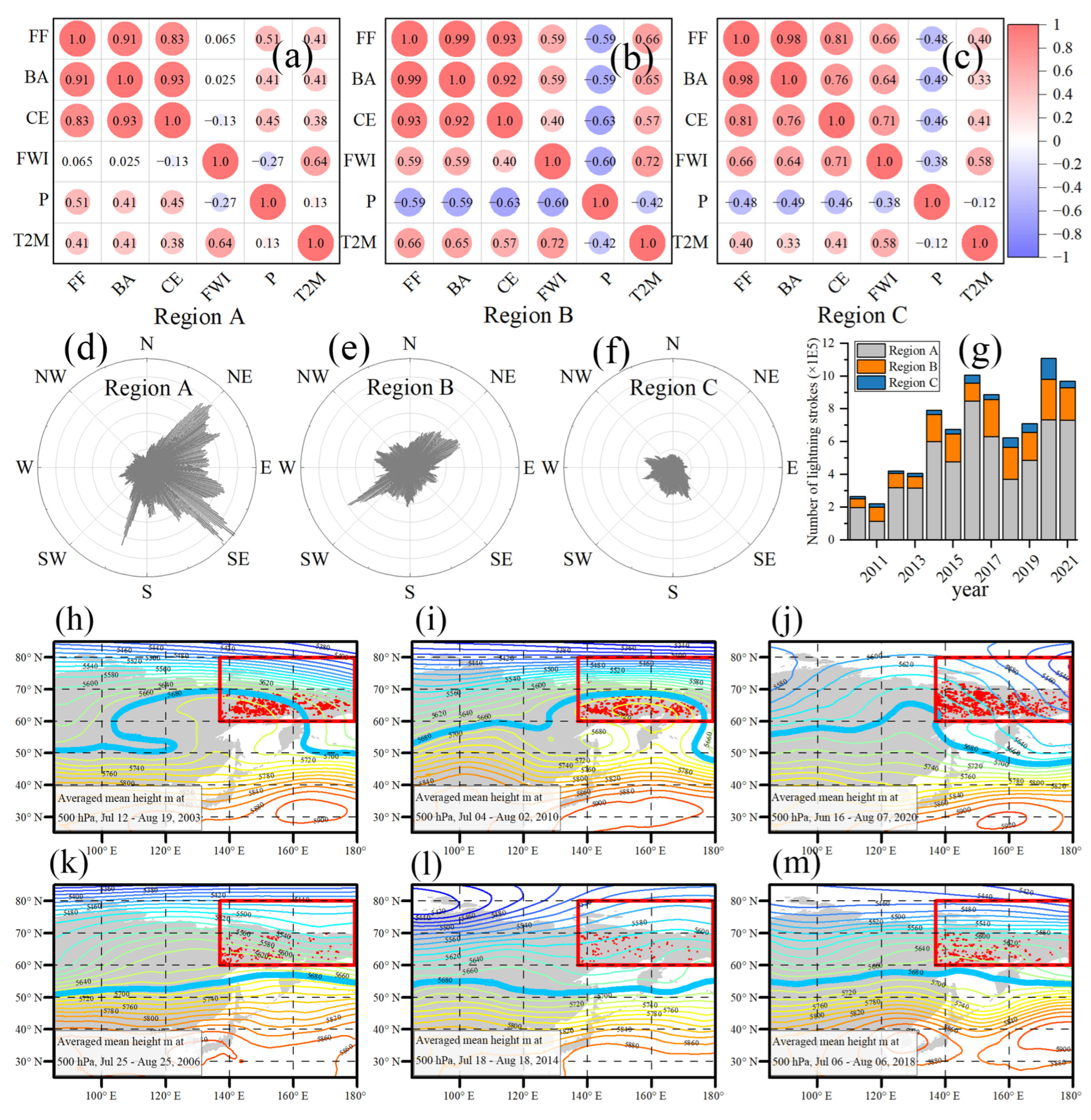
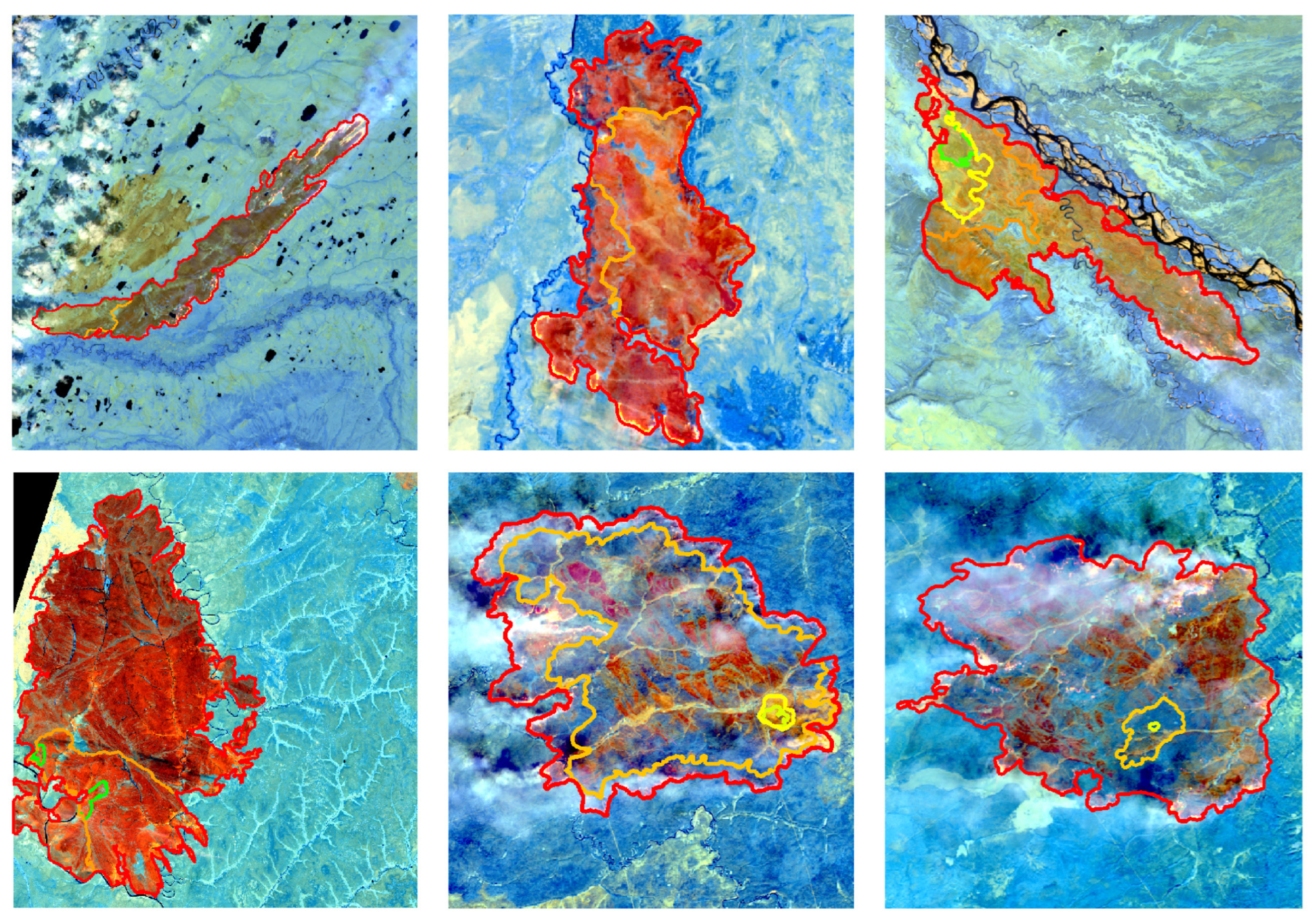
| Scale | Purpose | Period Covered | Revisit Time | Spatial Scale (Pixel Size) | Sensor | Product Used |
|---|---|---|---|---|---|---|
| 2001–2021 | Daily | 1 km | MODIS | MCD14ML | ||
| 2001–2021 | Monthly | 0.25° × 0.25° | Various | GFEDv4 | ||
| Fire incidence: daily and annual scale | 1982–2018 | Annual | 0.05° × 0.05° | AVHRR | FireCCILT11 | |
| CR | Spatial distribution of fires; Fire season | 1979–2020 | Daily | 1.0° × 1.0° | - | GPCP v2.3 |
| Biomass burning emissions | 1979–2021 | Daily | 0.25° × 0.25° | - | ERA5 reanalysis | |
| Fire weather conditions | 1979–2021 | Hourly | 0.1° × 0.1° | - | ERA5-Land | |
| 2010–2021 | Hourly | 0.5° × 0.5° | - | WGLC | ||
| MR | Area burnt per year | 2001–2020 | Annual 1 | 500 m | MODIS | GlobFire/MCD64A1 |
| Land cover | 2000–2019 | Annual | 300 m | Various | ESA CCI | |
| FR | Evolution of individual fires | 2017–2021 | Average 5 days | 20 m | Sentinel-2 | Fire Front Dataset 2 |
| Land cover | 2016–2020 | Annual | 300 m | Various | ESA CCI |
| Forest | Wetland | Scrubland/Herbaceous | Tundra | Others | Total | |
|---|---|---|---|---|---|---|
| Total burnt area (km2) | 397,614 | 12,025 | 17,426 | 15,160 | 14,084 | 456,309 |
| Proportion of total (%) | 87.1 | 2.6 | 3.9 | 3.3 | 3.1 | 100.0 |
| Type/A (%) | 68.1 | 17.4 | 7.8 | 2.4 | 4.3 | 100.0 |
| Type/B (%) | 94.2 | 1.2 | 2.4 | 0.6 | 1.6 | 100.0 |
| Type/C (%) | 74.8 | 1.3 | 6.0 | 11.2 | 6.7 | 100.0 |
| A/ALL (%) | 6.7 | 57.0 | 17.7 | 6.4 | 12.0 | - |
| B/ALL (%) | 71.9 | 30.5 | 42.8 | 10.5 | 33.9 | - |
| C/ALL (%) | 21.4 | 12.5 | 39.5 | 83.1 | 54.1 | - |
| Total | 100.0 | 100.0 | 100.0 | 100.0 | 100.0 | - |
| Region | Duration (Days) | Daily Area of Expansion (km2/d) | Propagation Speed of Fire Fronts (m/d) | Main Propagation Direction of Fire Fronts |
|---|---|---|---|---|
| All (60–75°N) | 13 | 7.5 | 442 | West and NE |
| A | 6 | 2.6 | 464 | NW |
| B | 18 | 8.6 | 388 | West and NE |
| C | 10 | 14.1 | 832 | SW, NW and NE |
| Adj. region (50–60°N) | 8 | 3.0 | 280 | SW and NE |
Publisher’s Note: MDPI stays neutral with regard to jurisdictional claims in published maps and institutional affiliations. |
© 2022 by the authors. Licensee MDPI, Basel, Switzerland. This article is an open access article distributed under the terms and conditions of the Creative Commons Attribution (CC BY) license (https://creativecommons.org/licenses/by/4.0/).
Share and Cite
Zhou, Y.; Ji, S.; Warner, T.A. Regional Spatiotemporal Patterns of Fire in the Eurasian Subarctic Based on Satellite Imagery. Remote Sens. 2022, 14, 6200. https://doi.org/10.3390/rs14246200
Zhou Y, Ji S, Warner TA. Regional Spatiotemporal Patterns of Fire in the Eurasian Subarctic Based on Satellite Imagery. Remote Sensing. 2022; 14(24):6200. https://doi.org/10.3390/rs14246200
Chicago/Turabian StyleZhou, Yikang, Shunping Ji, and Timothy A. Warner. 2022. "Regional Spatiotemporal Patterns of Fire in the Eurasian Subarctic Based on Satellite Imagery" Remote Sensing 14, no. 24: 6200. https://doi.org/10.3390/rs14246200
APA StyleZhou, Y., Ji, S., & Warner, T. A. (2022). Regional Spatiotemporal Patterns of Fire in the Eurasian Subarctic Based on Satellite Imagery. Remote Sensing, 14(24), 6200. https://doi.org/10.3390/rs14246200






